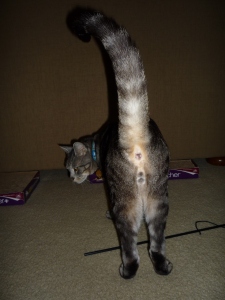
My boy kicked off the E-collar the moment he set foot in the house and he did not wear it again. Most male cats do not need sutures but they have medical glue on them as the glue not only hold the slit close but they form a film like cover to keep bacteria away as not to get the surgery site infected and that's why E-collars are used so that they don't licked the surgery area. The younger the cat, the smaller the scrotum and thus the smaller the slit. The condition does become painful if it reaches the point where lesions swell and/or scab, so this is the point where more aggressive treatment is required to manage your cat’s acne.Click to expand.Yes, the slit is small but not small as it's so tiny and it also depends on how old your cat is. Most cases of feline chin acne are relatively harmless and respond well with improved hygiene. If your cat is plagued with chin acne, remember this is usually only a superficial problem and not one that will have serious impacts on your cat’s overall health. Your vet may recommend cleaning their face with benzoyl peroxide facial wipes, but you need to get wipes specifically made for cats, as human wipes are too strong.Ĭlipping the nearby fur can also cut down the amount of bacteria.Ĭleaning water and food dishes with increased frequency and a switch to stainless steel, glass, or ceramic dishes may also help for some cats. Tips for Cleaning Your Cat’s Face If They Have Acneįor most patients, improved hygiene is core to the treatment plan in other words, you are going to need to start washing your cat’s face. Maintenance cleansing with gentle scrubbing has been successful for many cats because it extends the amount of time between episodes and treatment.

CAT NEUTERED TINY BALLS SKIN
If your cat’s skin begins to clear, the shampoos and topical treatments can gradually be stopped, but if the outbreaks reoccur, your veterinarian will help develop an appropriate maintenance routine to keep your cat’s chin as clear as possible. Initially, treatment may involve the use of oral or injectable antibiotics and topical shampoo or wipes. Picking will only worsen the condition and potentially cause more pain and even infection. Your veterinarian will diagnose feline acne based upon clinical findings, your cat’s medical history, and the elimination of other possible skin conditions.Ī skin scraping and cytology may be needed to help rule out other causes, such as mange, various skin tumors, and a condition called eosinophilic granuloma complex. Regardless of the underlying mechanism, the result is that the hair follicle becomes “plugged,” and an infection often results. When these blackheads become infected with bacteria, they form pustules that look like quite similar to what you would recognize to be pimples.Ĭat acne is believed to be associated with:Įxcessive sebum (oil) and keratin production Causes of Cat Acneįeline acne is a poorly understood disorder that’s related to the overproduction of keratin-a key structure that makes up the outer layer of skin.įor a variety of reasons, this excess keratin becomes trapped, causing the formation of blackheads, or comedones. It can also lead to chronic hair loss in the affected area. As the lesions get bigger, the follicles are more prone to rupture, which is a very sore (and messy) experience. Chronic Acne in CatsĬhronic or severely affected cats may have so many plugged follicles that they fuse together and form swollen, painful crusts. The lesions can also be found on your cat’s upper and lower lips.


The most common clinical sign associated with feline acne is a chin that looks dirty, hence the name “feline chin acne.” Your cat’s chin may look like it has specks of dirt all over it-you may even be tempted to try to wipe their chin to clean it.Ĭat acne may also appear as red pimples or pustules with a head like pimples before they pop. Additionally, feline acne affects males and females of all breeds, as well as both and neutered and intact cats. This results in red bumps, blackheads, and infected pimple-like lesions.Ĭats can have a single, isolated bout of chin acne, or it may be a chronic struggle.Ĭats of all ages can develop acne, as it is not believed to be related to sex hormones.

If you’ve ever noticed red bumps, black dots, or dirt on your cat’s chin, your cat may struggle with feline acne, often called chin acne.Īt its basic definition, cat acne is a disease in which the hair follicles-usually ones on a cat’s chin-produce too much keratin and become plugged.


 0 kommentar(er)
0 kommentar(er)
